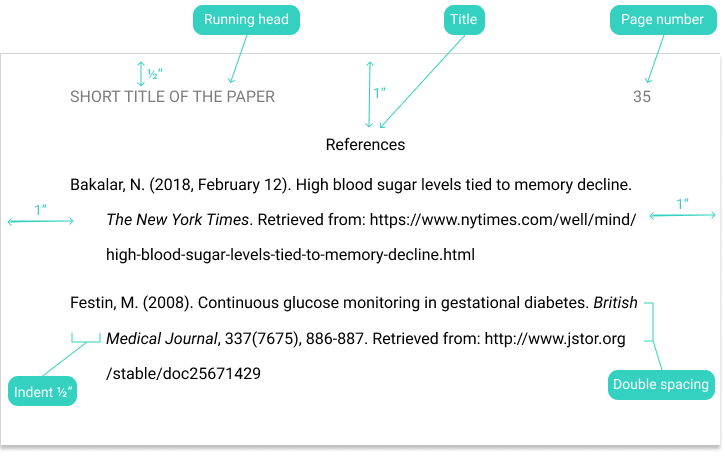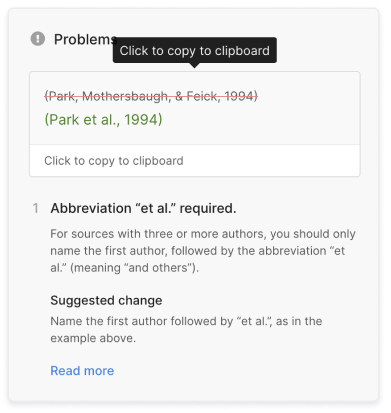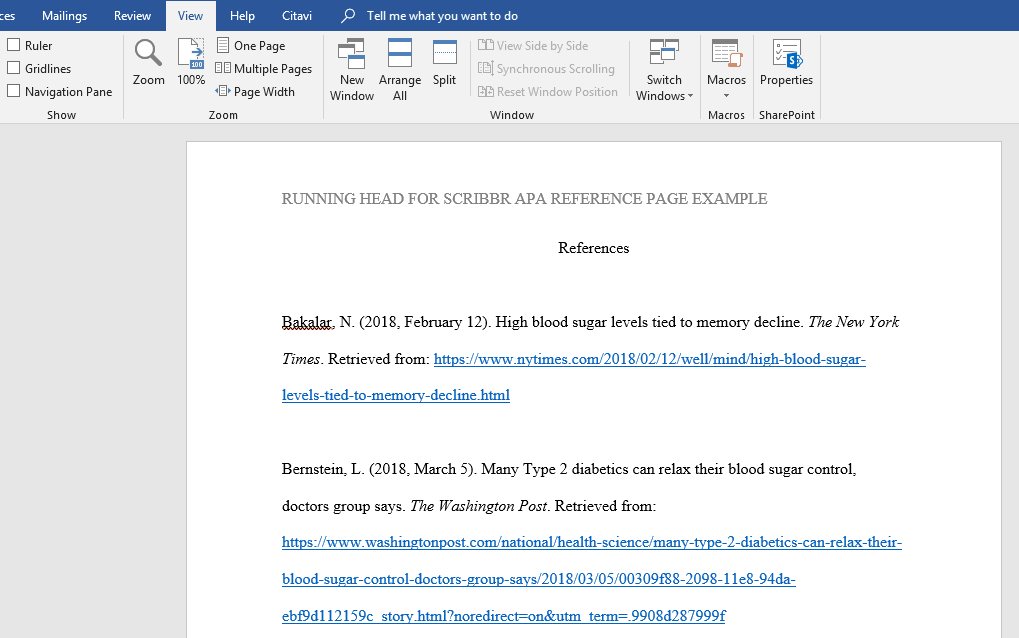APA reference page formatting | 6th edition guidelines
The APA reference page is a separate page at the end of your paper where all sources you cited in the main text are listed. The references are sorted alphabetically, double spaced, and formatted using a hanging indent of ½ inch. Use “References” as page heading and include a running head with your paper title and page number.
APA reference page example
Creating references in APA format
Each reference must be structured according to the rules for that source type. These rules vary between books, journal articles, internet articles and more. APA references can be created either manually or by using an APA Citation Generator.
The Scribbr APA Citation Generator is free of ads and can automatically cite your sources based on the website URL, journal DOI or book ISBN.
You should include a reference for all sources you have cited in the text. Don’t include sources you have only consulted. There are four types of source that are never included in an APA reference page:
- Classical works such as the Bible
- Personal communication such as emails, telephone conversations and chat messages
- Entire websites (always cite the page)
- Common knowledge
Generate accurate APA citations with Scribbr
Multiple authors in APA
A standard source reference begins with the author’s surname, followed by a comma, then the initial(s) of his or her first name.
If there are multiple authors, place a comma between each of the author names and an ampersand (“&”) before the last author’s name. If there are more than eight authors, list the first six followed by an ellipses “…” followed by the last author.
There should always be a period after the author name(s).
| Number of authors | Example (journal article format) |
|---|---|
| 1 author |
Bentham, G. (1996). Association Between Incidence Of Non-Hodgkin’s Lymphoma And Solar Ultraviolet Radiation In England And Wales. BMJ: British Medical Journal, 312(7039), 1128-1131. Retrieved from http://www.jstor.org/stable/29731519 |
| 2 authors |
Mead, G., & Whitehouse, J. (1986). Regular Review: Modern Management Of Non-Hodgkin’s Lymphoma. British Medical Journal (Clinical Research Edition), 293(6547), 577-580. Retrieved from http://www.jstor.org/stable/29524395 |
| 3 – 7 authors |
Ishii, K., Hosoi, Y., Yamada, S., Ono, T., & Sakamoto, K. (1996). Decreased Incidence of Thymic Lymphoma in AKR Mice as a Result of Chronic, Fractionated Low-Dose Total-Body X Irradiation. Radiation Research, 146(5), 582-585. https://doi.org/10.2307/3579560 |
| 8+ authors |
Zoufaly, A., Stellbrink, H., An der Heiden, M., Kollan, C., Hoffmann, C., Van Lunzen, J., . . . ClinSurv Study Group. (2009). Cumulative HIV Viremia during Highly Active Antiretroviral Therapy Is a Strong Predictor of AIDS-Related Lymphoma. The Journal of Infectious Diseases, 200(1), 79-87. Retrieved from http://www.jstor.org/stable/40255115 |
Formatting the reference page
An APA reference page must also adhere to various format requirements, including indentation, spacing and margins. It is also vital that your reference list is alphabetized. This is how it should look:
- One inch (2.54 cm) page margins on all sides
- Times New Roman font in 12 pt
- ‘References’ as title (centered)
- Running head (top left corner)
- Page number (top right corner)
- Double spacing within and between references
- ½ inch hanging indent for references longer than one line.
Setting up in Google Docs
This video will demonstrate how to format the APA reference page in Google Docs.
Alignment instructions for Word
- Make sure you can see the ruler at the top of the page (change the setting under the “View” tab if you cannot).
- Select all text in the reference list.
- The ruler will show two triangles and one square. Drag the bottom triangle to the right, half an inch, to set the hanging indent.
Dividing URLs
Microsoft Word sees a URL as one word and will always split a long URL over more than one line. This often leaves a lot of white space. See the screenshot below:
To avoid this, you want Word to divide the URL after a slash. You can divide a URL after a slash by placing your cursor after the slash and then clicking on Insert → Symbol → More Symbols… → Special Characters. Then add the character “No-Width Optional Break” or type ALT+8203.
You can also do this for all the slashes in your document by using the Find and Replace function in Word. At “Find what”, insert a slash. At “Replace with” insert a slash and then type ALT+8203. Then click “Replace All.”
Alphabetizing
The last step in creating the perfect APA reference page is to ensure the sources are correctly alphabetized, usually based on the author’s surname. Word can do this automatically for you. We also wrote an in-depth article on how to alphabetize the APA reference list.
APA format for other sections
The reference page is not the only part of your paper with specific formatting requirements in APA Style. Read our guide to APA formatting or see our articles on the APA format guidelines of the title page, running head, abstract and headings.
In October 2019, APA also released the 7th edition APA Manual. Check with your supervisor to see which edition your paper needs to adhere to.
Cite this Scribbr article
If you want to cite this source, you can copy and paste the citation or click the “Cite this Scribbr article” button to automatically add the citation to our free Citation Generator.
Gahan, C. (2022, May 19). APA reference page formatting | 6th edition guidelines. Scribbr. Retrieved November 3, 2023, from https://www.scribbr.com/apa-style/6th-edition/archived-reference-page/



